Return to theme table of content
Return to VJIC table of content
Thread # 7
LIBERATION
© Robert Hirsch 2023
www.lightresearch.net
VASA Journal on Images and Culture (VJIC),
Theme Editor and Writer
“I IMPLORE YOU TO BELIEVE THIS IS TRUE!”
Lee Miller
This essay examines the role photography has played in shaping a public Holocaust narrative following the arrival of Soviet and Allied forces at the Nazi work and death camps. This piece also scrutinizes the complex emotional, physical, and political challenges the liberated prisoners confronted and how their liberators attempted to assist them in salvaging their devastated lives at the start of the Cold War. Between 1933 and 1945, Nazi Germany and its allies established more than 44,000 camps and other incarceration sites, including ghettos.[i] The perpetrators utilized these sites for forced labor, detention of people considered to be enemies of the state, and mass murder. Owing to the enormous scope of the German concentration camps, select examples will represent the many.
Note: Additional information about some of the images can be found at the end of this essay (Image Notes). Images have been minimally adjusted to facilitate online viewing, but have not been overtly edited from their source.
On the night of July 22-23, 1944, Red Army soldiers came upon the Majdanek concentration camp, much to the relief of the inmates. Captured virtually intact, soldiers liberated just under 500 prisoners and occupied the nearby Polish city of Lublin on July 24, 1944. Soviet officials invited journalists to inspect the camp for evidence of the atrocities that had occurred there. What Soviet and Polish researchers uncovered and documented was quickly reinforced by the investigative work conducted by others outside of the USSR, definitively shaping our understanding of the Nazi genocide. While still largely unfamiliar to most Americans, the liberation of Majdanek was one of the most significant moments in the history of World War II and the Holocaust. Even within the SS, Majdanek’s personnel were known for their savagery. Historian Doris Bergen describes Majdanek’s SS contingent as “sadists who enjoyed killing children in front of their mothers and forcing the prisoners to engage in deadly ‘sports.’” In 1943, following resistance in the Treblinka and Sobibor camps as well as the Warsaw Ghetto uprising, the SS decided to murder all Jews located in the Majdanek area. On November 3, 1943 over 18,000 Jews were assembled and then shot dead outside the camp. Throughout the massacre, the camp’s loudspeakers played music to drown out the sounds of the slaughter. The camp had some 227 structures in all, including seven gas chambers and two wooden gallows, placing it among the largest of Nazi concentration camps. It is estimated that between 95,000 and 130,000 people were murdered there. The camp’s capture, before the Germans could destroy it, provided devastating verification of the Nazi’s extermination system and amplified the call for justice in the cemetery that was Europe.[ii] Majdanek remains the best preserved evidence of the horrors of the Nazi extermination camps.
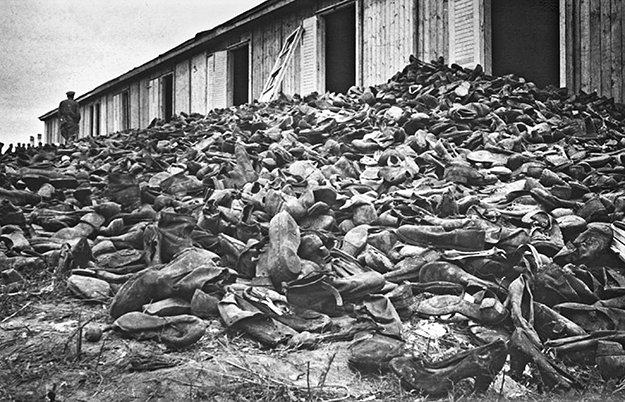 7.1 Unknown photographer. Victims’ shoes at Majdanek, Majdanek, Poland, August 1944. A Soviet soldier walks through a mound of victims’ shoes piled outside a warehouse in Majdanek soon after the liberation. United States Holocaust Memorial Museum.
7.1 Unknown photographer. Victims’ shoes at Majdanek, Majdanek, Poland, August 1944. A Soviet soldier walks through a mound of victims’ shoes piled outside a warehouse in Majdanek soon after the liberation. United States Holocaust Memorial Museum.
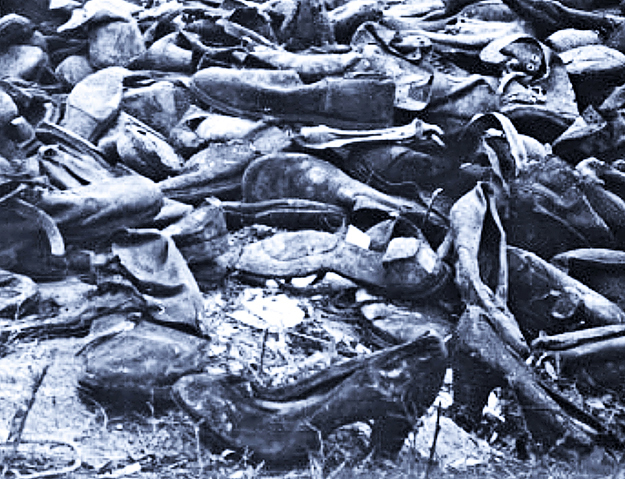 7.1B Detail. Unknown photographer. Victims’ shoes at Majdanek, Majdanek, Poland, August 1944.
7.1B Detail. Unknown photographer. Victims’ shoes at Majdanek, Majdanek, Poland, August 1944.
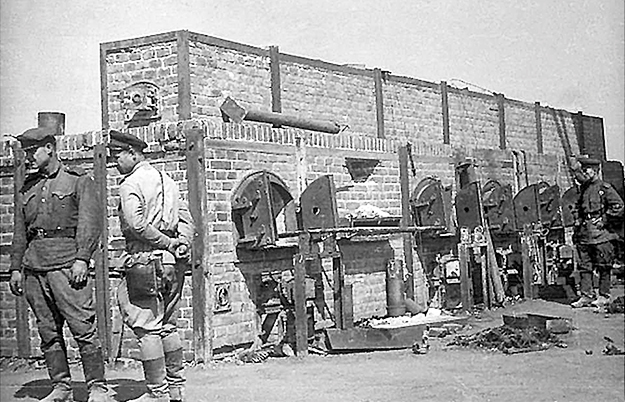 7.2 Unknown photographer. Soviet soldiers inspect the ovens at Majdanek, July 1944. Courtesy of Deutsche Fotothek.
7.2 Unknown photographer. Soviet soldiers inspect the ovens at Majdanek, July 1944. Courtesy of Deutsche Fotothek.

7.3 American Nationalist. Buy Gentile. Patronize only Christian Merchants, Boycott Jew Stores. Photo offset.
This belated information was critical as major figures in the American leadership, including President Franklin Delano Roosevelt and key cabinet members, agreed that maintaining public support of the war effort required downplaying any thoughts that war was about the Jews. No Allied bombers were sent to Auschwitz even though Allied raids were targeting the German chemical plant IG Farben, which was located just 4 miles (6 kilometers) from the death camp and relied on Auschwitz prisoners for slave labor. Excuses included imprecise bombing techniques and the killing of inmates. However, the underlying reason can be traced to widespread antisemitism in the U.S. and the U.K., which was fanned by Nazi propaganda that argued that Jews were controlling the Allied war effort.
Leading up to US involvement in World War II, American antisemites, such as Father Charles Coughlin and the American Christian Front, along with congressional leaders and celebrities like Charles Lindbergh, followed the Nazi example by advocating for the boycott of Jewish businesses by spreading lies that Jewish business people were forcing Christians out of business, and advocating violence against Jews.[iii] Today, antisemites urge boycotting Israel as a first step to eradicating Israel’s existence and making the Mideast Jew-Free.
Once the initial joy and relief of liberation from assured death passed, the majority of the Holocaust survivors faced a new reality. Many survivors resembled the Muselmänner[iv] – the living dead[v] – existing in a state Italian philosopher Giorgio Agamben called “Bare Life.” After being liberated by the Soviets from Lichtewerden in Czechoslovakia, Bela Braver recalled:
The Russians entered and we were in such a condition (bones without flesh) that no one moved, no one went out. We did not laugh, we were not happy, we were apathetic – and the Russians came. A general came in, he was Jewish. He told us that he was delighted, as this was the first camp in which he had found people still alive (as the Russians advanced the Germans forced prisoners on death marches to Germany). He started to cry; but we didn’t. He wept and we didn’t.[vi]
Regardless of where they were liberated from, the former Jewish captives were paralyzed by intense feelings of exhaustion, fear, guilt, and shame for having survived, while also suffering devasting grief for lost family members, friends, and their entire way of life. In addition, they had immense medical and phycological problems that needed attention. Jews, unlike other prisoners, did not have families waiting for them nor homes to go back to—most had no place to go. They were people without a country, stranded in Displaced Persons (DP) camps where they were often confined with their torturers, and not permitted to emigrate to destinations of their choice as no country wanted them. Many survivors, particularly in Eastern Europe, continued to experience violent and murderous antisemitism when they returned to their communities. For example, it is estimated that between 1000 to 2000 returning Jews were murdered by their pre-war neighbors in Poland, demolishing any hope for rebuilding Jewish life in Poland. The reality for most survivors was that they were utterly alone in the world.[vii]
As concentration camp inmates were strictly prohibited from having any photographic equipment, the vast majority of photographs and films made of the camp liberations were made by military photographers or journalists attached to the Allies and Russians.
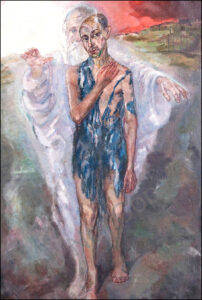
7.4 Eliazer Neuburger, Ahasver (The Wandering Jew), Amsterdam, 1947.
The anguish that accompanied liberation was revealed after-the-fact by survivor-artists, such as Eliazer Neuburger (1891–1972), in drawings and paintings. The Yad Yashem Art Museum describes one of his paintings Ahasver (The Wandering Jew) (7.4): “A man, barefoot and exposed, wearing torn garments gazes at the viewer with a guilty countenance. Behind him an elderly, mysterious figure reminiscent of the prophet Elijah raises his hand as in giving a blessing. The contrast between the figures is echoed in the background: next to a smoke-filled, burning sky, there appears a hint of an illuminated Star-of-David. Neuburger, who survived the Holocaust, paints the survivor in the figure of the wandering Jew, whether blessed or cursed unclear, who continues down the via dolorosa of the chosen people.”[viii]
On January 27, 1945, the Soviets also liberated Auschwitz-Birkenau, the largest German killing center, which was actually a group of camps, designated I, II, and III, including 40 smaller satellite camps.
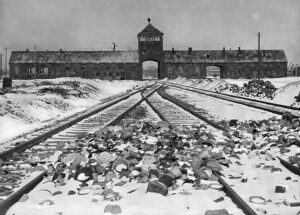
7.5 Unknown photographer. Discarded, snow-covered personal effects litter the train tracks leading to Auschwitz-Birkenau entrance, circa 1945.
Upon entering the camp, Soviet soldiers found over six thousand emaciated and diseased prisoners alive. They also found hundreds of thousands of men’s suits, more than 800,000 women’s garments, and more than 14,000 pounds of human hair.
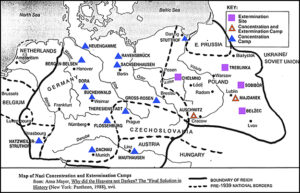
7,6
As Allied troops moved across Europe in a series of offensives on Germany, they encountered and liberated concentration camp prisoners, many of whom had survived death marches into the interior of Germany. The Soviets liberated major Nazi camps including Majdanek, Auschwitz, Stuffhof, Sachsenhausen, and Ravensbrück. US forces liberated Buchenwald, Dor-Mittelbau, Flossenbürg, Dachau, and Mauthausen camps. British forces liberated camps in northern Germany, including Neuengamme and Bergen-Belsen. There was little food at Bergen-Belsen and the camp was filthy and crawling with vermin. Many prisoners fell ill, including Margot and Anne Frank, who contracted spotted typhus and died there in February 1945. The Allies were appalled at what they found and immediately began making photographs and films of the walking skeletons and abundant corpses.
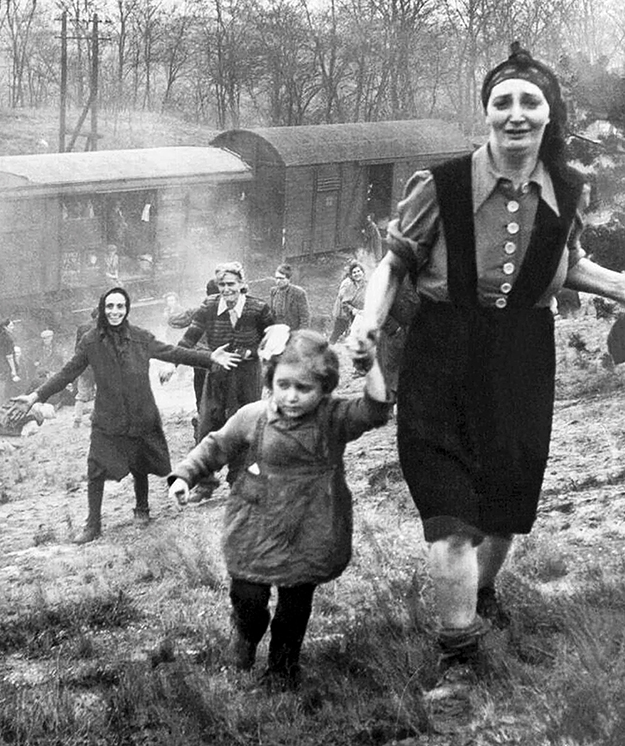
7.7 Major Clarence L. Benjamin. Jewish prisoners after being liberated from a death train, April 13, 1945. Variable dimensions. Gelatin silver print.
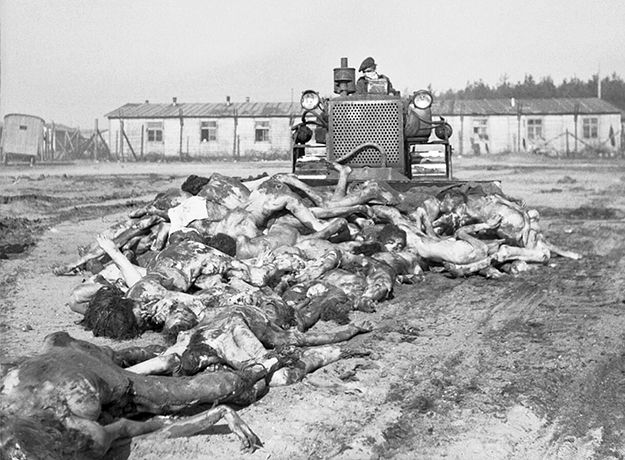 7.8 Sergeant Harry Oakes (1921-1912), A British Army bulldozer pushes bodies into a mass grave at Bergen-Belsen, April 19, 1945. Dimensions vary. Gelatin silver print. Imperial War Museums, UK.
7.8 Sergeant Harry Oakes (1921-1912), A British Army bulldozer pushes bodies into a mass grave at Bergen-Belsen, April 19, 1945. Dimensions vary. Gelatin silver print. Imperial War Museums, UK.
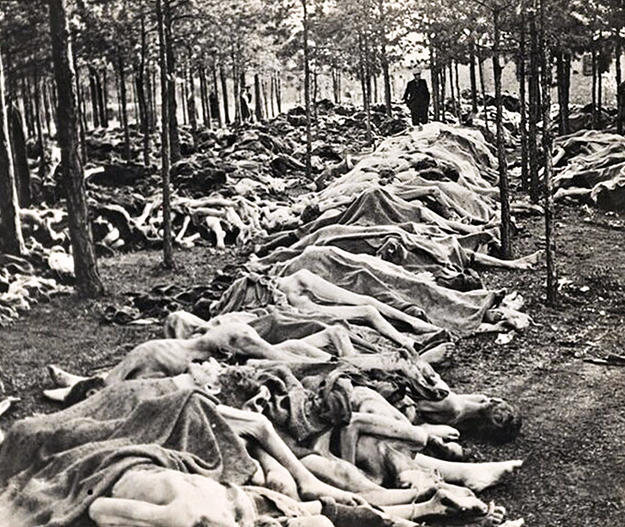
7.9 Sergeant Harry Oakes. Corpses, Bergen-Belsen, April 17, 1945. 6-13/16 × 7-15/16 inches. Gelatin silver print. National Gallery of Art, Washington, DC.
Even with overwhelming visual evidence and testimony from Allied and Russian troops, Holocaust denial and distortion continues to be a world-wide problem. Deniers claim that the Holocaust was invented or exaggerated by Jews as part of a plot to advance Jewish interests. The deniers misuse of historic facts perpetuate long-standing antisemitic stereotypes and hateful beliefs that helped provide the groundwork for the Holocaust.[ix]
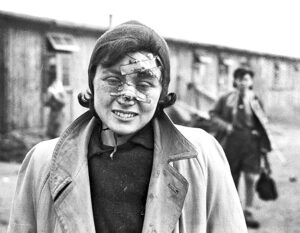
7.10 Captain E. G. Malindine. Beaten woman prisoner, Bergen-Belsen, April 18, 1945. Dimensions vary. Gelatin silver print. Imperial War Museums, UK.
Survivors did not seem to oppose being photographed. Even in their shocking state they seemed to intuitively understand these were not personal portraits, but rather they were being objectified as evidence of what the Germans had done not only to them, but to their families, friends, and communities. In that sense they were ghostly portraits of not only of those still living, but also of the incorporeal beings who had perished. Nevertheless, they had no agency in how they were depicted, at likely the lowest mental and physical conditions of their lives.
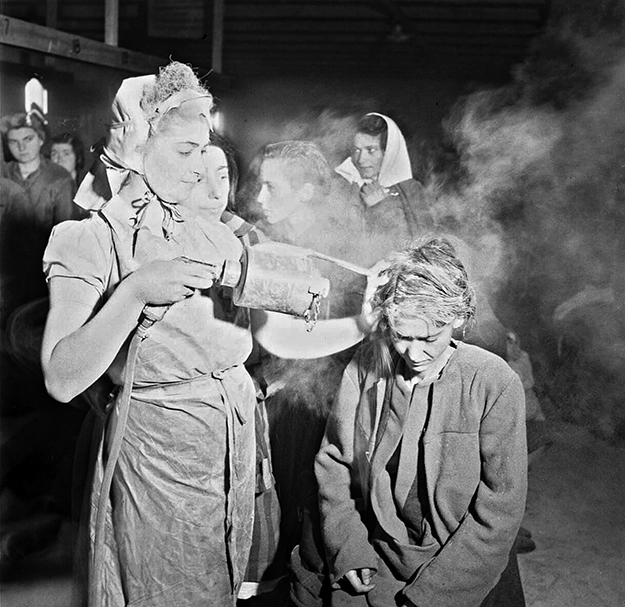
7.11 Sergeant C. H. Hewitt. De-louseing, May, 4, 1945. Dimensions vary. Gelatin silver print. Imperial War Museums, UK.
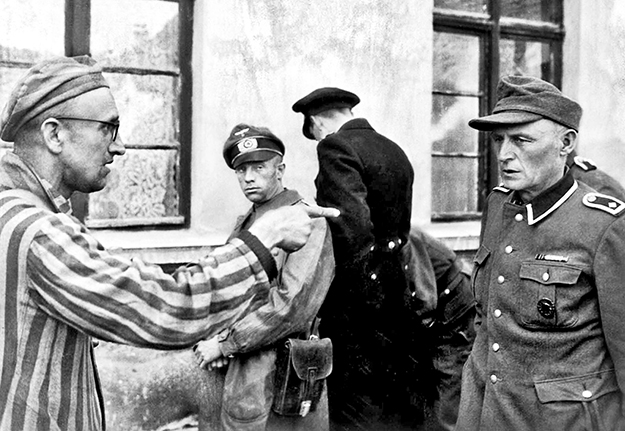
7.12 Unknown photographer. Identifying Nazi guard who brutally beat prisoners, May 14, 1945. Dimensions vary. Gelatin silver print. United States Holocaust Memorial Museum, Washington, DC.
The colorizing of Shoah photographs and films is a controversial subject. The Auschwitz Museum hired Brazilian artist Marina Amaral to colorize photographs for their Faces of Auschwitz project. Amaral stated: “When we see the photos in black and white, we get the feeling that those events happened only in the history books…. By restoring the colors on her face, I was able to show the colors of the blood and the bruises, which made everything even more real,”[x] which reduces the distance between the contemporary viewer and the subject. Critics say it distorts the historic record, especially in a time of world-wide Holocaust denial.[xi]
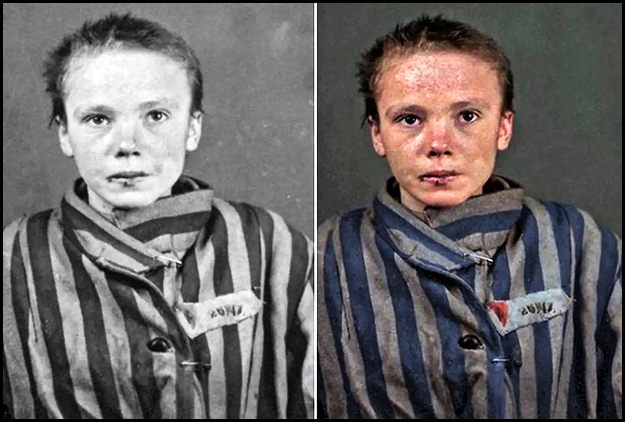
7.13 Unknown photographer and © Marina Amaral. Czesława Kwoka, circa 1944. The Auschwitz-Birkenau State Museum, Oświęcim, Poland.
Margaret Burke-White (1904-1971), who was American’s first accredited woman photographer in WWII, arrived at Buchenwald in April 1945 with General George Patton’s Third Army. Burke-White state that “Using a camera was almost a relief. It interposed a
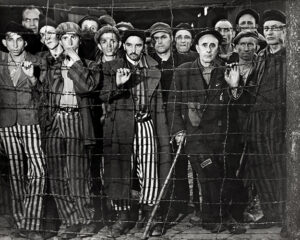
7.14 Margaret Burke-White. The Living Dead at Buchenwald, 1945. Dimensions vary. Gelatin silver print. © Estate of Margaret Bourke-White.
slight barrier between myself and the horror in front of me.”[xii] The editors of Life magazine did not believe these photographs until their other photographers sent in their film from the other Nazi camps. Life waited for three weeks before publishing some of the photographs in the May 7, 1945 issue with the caption: “Dead men will have indeed died in vain if live men refuse to look at them.” One thing the photographs do not convey is what Time correspondent Percy Knauth reported: “they stink like nothing else on earth and many…have lost the power of coherent speech.”[xiii] Although it was not published until 15 years later, The Living Dead at Buchenwald, became one of the iconic Holocaust photographs for it contrasts Nazi barbarism with the stamina of prisoners who survived the concentration camps brutality. It is a striking example of how seeing is not necessarily about believing and how belief can override reality. It is also a marker of how few people wanted to even acknowledge what the Germans and their helpmates had done to the Jews and other groups that did not fit into their tribal identity.
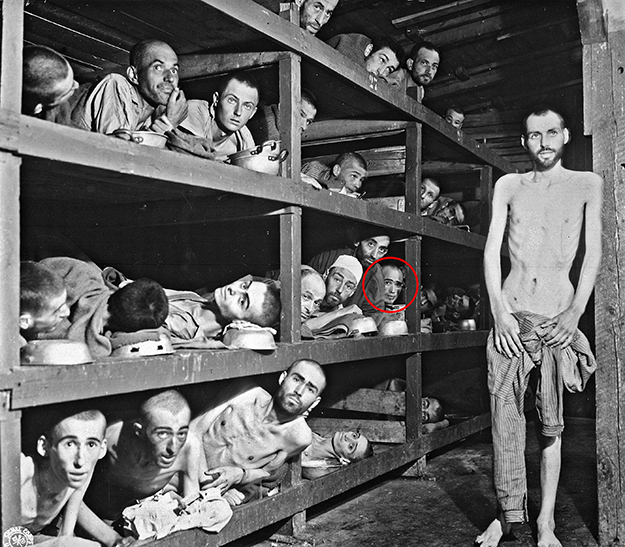
7.15 Unknown photographer. Elie Wiesel among other prisoners, Buchenwald, April 16, 1945. Dimensions vary. Gelatin silver print.
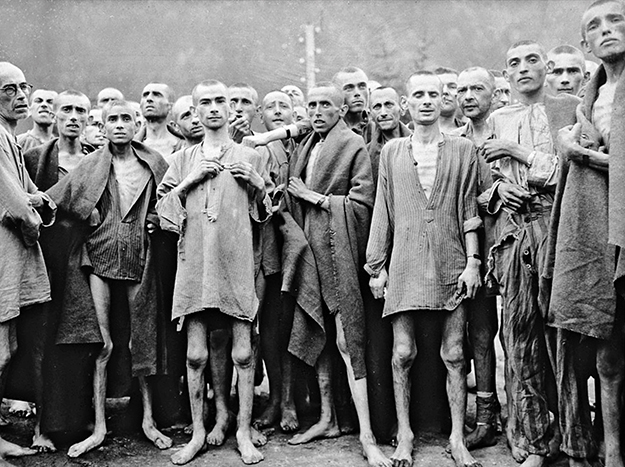
7.16 Arnold E. Samuelson. Liberated prisoners at Ebensee, May 7, 1945. Dimensions vary. Gelatin silver print. National Archives and Records Administration, College Park, MD.
By investing herself physically and psychologically, Lee Miller (1907-1977) utilized her artistic background to compose the insane revulsion of the Holocaust in a disturbingly, well-structured frame that encapsulated and memorialized what she saw. Images of concentration camp victims, made by Miller and reproduced in Life and Vogue, provided conclusive evidence that Germany had engaged in the systematic extermination of Jews, homosexuals, Jehovah’s Witnesses, Roma, political prisoners, the mentally and physically challenged, and other so-called undesirables, including artists, whom they demonized as unalterably dangerous, evil, and unredeemable.[xiv] At the time, when the world was oblivious and disbelieving to what took place in Nazi concentration camps, Miller, a former model, Surrealistic muse, and fashion photographer, wrote in a telegram: “I IMPLORE YOU TO BELIEVE THIS IS TRUE!” The June 1945 American edition of Vogue printed some of Miller’s death camp photographs along with the message: “Believe It.”[xv]
To make this visceral photograph of two US medics staring in disbelief at the dead prisoners inside the Dachau Death Train (7.17) with their hands wrapped around their bodies in a protective mode, Miller climbed inside the boxcar with the corpses and composed the devasting scene from the standpoint of the one of the victims. “Each car was filled with bodies impossibly tangled in rags, blood and excrement. Of the thousands packed onto the train, fewer than 20 still drew breath. There were signs of cannibalism. Beyond these horrific scenes, the terrible, cloying stench is often what remains uppermost in the memories of those who took part in the liberation.”[xvi]
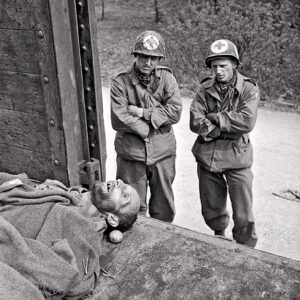
7.17 Lee Miller. US medics staring at a dead prisoner inside the Dachau Death Train, Dachau, Germany, 1945. Variable dimensions. Gelatin silver print. © Lee Miller Archives, England 2023. All rights reserved.
In a similar photograph (7.18), Doctor Jacques Hindermeyer, a French medical expert who was an eyewitness to this Nazi death train, stated that Miller took the photograph that he could not take as he was too overcome with revulsion when the G.I.s (sarcastic slang used by US military personnel referring to themselves as mass-produced “Government Issue” or “General Issue”) opened the door of the rail car and the rotting corpses flopped out.[xvii]
In figure 7.19 Miller’s tight composition drives viewers directly to the blood-smeared face in the frame’s center. By concentrating on one victim, she conveys the enormity of the atrocities. Her framing that co-mingles the corpses suggests, rather than shows, the gruesomeness, indicating the human annihilation was impossible to portray. It exhorts viewers to use their imaginations to insert what is not included in the photograph, constructing their own horror story based upon personal trauma. The dehumanizing tattooed number is visible on one corpse’s arm in the upper left of the frame.
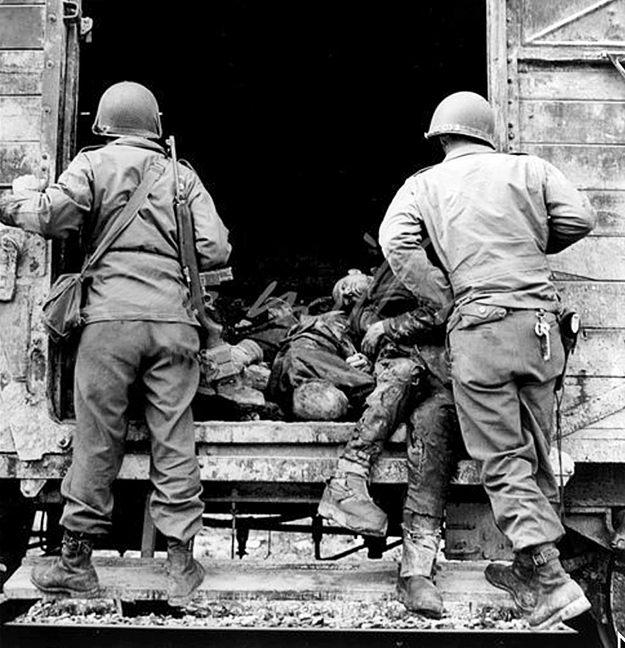
7.18 Lee Miller. US soldiers examine a rail truck loaded with dead prisoners, Dachau, Germany, 1945. Variable dimensions. Gelatin silver print. © Lee Miller Archives, England 2023. All rights reserved.
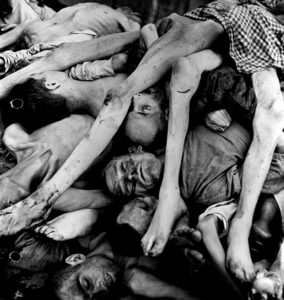
7.19 Lee Miller Buchenwald, Germany: Dead Prisoners, April 30, 1945. Variable dimensions. Gelatin silver print. © Lee Miller Archives, England 2023. All rights reserved.
The iconic picture of Lee Miller taking a bath in Hitler’s tub (7.19), washing away the outer filth of Dachau and leaving muddy boot prints on der Führer’s pristine white rug as his portrait overlooks the scene. Miller also took a nap in his mistress Eva Braun’s bed and took some of her personal items. She expressed outrage and disgust for the Germans.[xviii] She wrote to Roland Penrose: “When the invasion occurred – the impact of the decision itself was a tremendous release – all my energy and all my pre-fabricated opinions were unleashed together; I worked well and consistently and I hope convincingly as well as honestly. Now I’m suffering from a sort of verbal impotence…. This is a new and disillusioning world. Peace with a world of crooks who have no honor, no integrity and no shame is not what anyone fought for.”[xix]

7.20 David E. Scherman. Lee Miller in Hitler’s Bathtub, Prinzregentenplatz 27, Munich, 1945. Variable dimensions. Gelatin silver print. © Lee Miller Archives, England 2023. All rights reserved.
Miller’s work stands out for its ability to combine the urgency to be seen with personal, social-realistic aesthetics. At the time of their making Miller recorded what she witnessed first-hand with the results serving as news. Today her direct sensory photographic observations position them closer to common reality by simply stating: Look – here it is. This approach forms a direct connection of the dead with the living, making them important as visual tools for transmitting and reconstructing the past. Such evidential imagery leaves viewers with no escape except to avert one’s eyes. Such authentication has proved crucial to countering the waves of Holocaust denial and related conspiracy theories that have become more normalized.[xx] Sadly, making such photographs took a terrible toll on Miller. Her son stated that “after the war her suffering from post-traumatic stress disorder caused her to become a depressive and an alcoholic.”[xxi]
Shortly after Miller made these photographs, Victory in Europe Day, Germany’s unconditional surrender on May 8, 1945, was celebrated by large crowds in the streets of London and New York. Conversely, liberation came too late for thousands of survivors who died from an inability to access the food the liberators provided, eating too much, not being able to digest the food that was available, and/or from lingering disease, exhaustion and sheer angst.
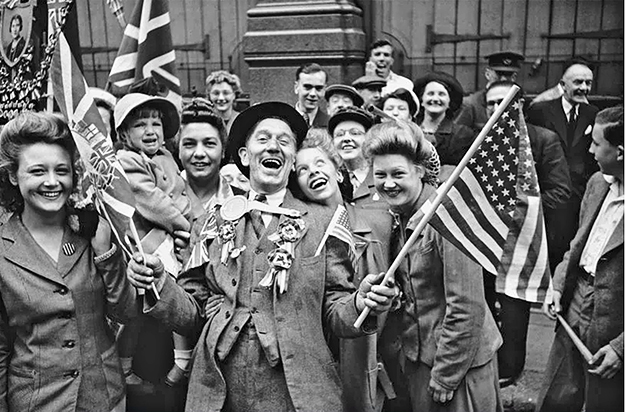
7.21 Unknown photographer. Londoners celebrate VE Day, May 8, 1945. Picture Post.
Holocaust photographs dominate the historical record when words and numbers fail because they “show us” what people are capable of doing to other people. The majority of these photographs are artless documents, without aesthetic aspirations, that literally show
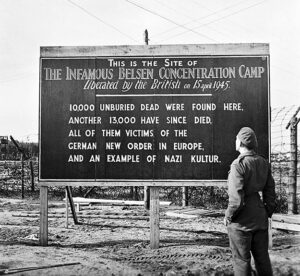
7.22 Sergeant C. H. Hewitt. Sign erected by British Forces at the entrance to Bergen-Belsen concentration camp, Germany, May, 29, 1945. Dimensions vary. Gelatin silver print. Imperial War Museums, UK.
us a scene as opposed to evoking one. Their ethical power comes from their indexicality, their ability to visually bear witness and transmit that which is unknown to the public with elemental fidelity. People found these images convincing because they were circulated by mass print media, such as Life magazine, which many people were familiar with, had confidence in, and thus could generate a mutual understanding and agreement about the Shoah. This is crucial to how history is later comprehended and remembered, which can involve understanding, denial, and/or revision of these primal visual testimonies and thus contribute to forming cultural memory. Keeping these images in circulation helps ensure they will be remembered, which is photography’s original mission. Photographs raise questions; they rarely answer them. However, by acting as memory aids they can re-energize their original “show-me” evidentiality purpose.
On a fundamental level, liberation changed nothing for European Jews who continued to have no agency of their own. Those who survived were in the same position as before the Final Solution: still widely considered to be homeless parasites who could never be “real” Germans or Hungarians, and so on. Many had no place to return to as the Nazis and their neighbors had stolen all of their worldly possessions. Traumatized survivors did not even
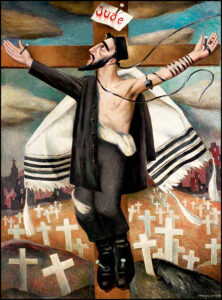
7.23 Emmanuel Levy. Crucifixion, 1942. 40.25 x 30.75 inches. Oil on canvas. Ben Uri Gallery and Museum, London.
get to tell their story at the time of liberation— it was recorded and structured by the Allies, who portrayed them anonymously…people without names, history, or homes. This served to reinforce the dehumanizing process the Germans had implemented by taking away their names and tattooing them with numbers.
Those detained in DP camps were classified as stateless and denied the freedom to travel. Even during the Nuremberg Trials of 1945 – 1946, Jews remained only bystanders. The Shoah also plainly demonstrated that even assimilated European Jews did not fit into the narrow spaces they were allowed to occupy in the overwhelmingly Christian societies. Clearly, a new direction that combined the political, social, and religious spheres was needed if the surviving Jews were to end their ceaseless wandering and have the opportunity to determine their own future.
The next theme essay will examine the outcomes of liberation.
Afterword
It is not enough to ask what happened when the Nazis implemented the genocidal “Final Solution to the Jewish Question” at the Wannsee Conference of January 1942. One must also dissect why the Shoah occurred in the first place, by identifying patterns that played out in advance, such the Nuremberg Laws (1935), Kristallnacht (1938), and the Wannsee Conference. It is impossible discuss the Holocaust without examining the causes and role of antisemitism, which has once again been escalating worldwide.[xxii]
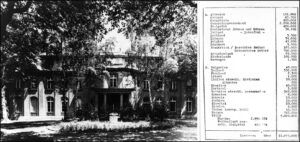
7.24 Wannsee Conference site, 1942. Courtesy of Bildarchiv preussichen Kulturbesitz, Berlin.
Antisemitism results from deep and abiding grievance, whose source in Christian religious teachings has been deviously equated to the wicked Jews, making antisemitism a righteous crusade. Once the origin of their unquenchable woes has been identified, the details of getting rid of the source does not matter. Many in Germany blamed their loss of World War I on traitorous, satanic Jews within Germany who stabbed Germany in the back,[xxiii] making it necessary for them to be purged to restore Deutscher Nationalismus. Seizing on this ideological notion that promotes the unity of Germans and German-speakers into one unified nation state, the Nazis both changed and revealed Germany, resulting in the Shoah.
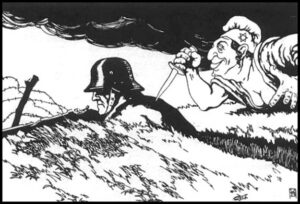
7.25 Published in Arbeiter-Zeitung (Workers’ Newspaper) Vienna, March 26, 1919, this illustration from an Austrian postcard portrays a repulsive, stereotypical Jew stabbing a personified German Army soldier in the back with a dagger. The capitulation of the Central Powers (the German Empire, Austria-Hungary, the Ottoman Empire, and the Kingdom of Bulgaria) was blamed upon the unpatriotic populace, Bolsheviks, socialists, the Weimar Republic and especially The Jews.
After declining in the post-war era, antisemitism in the US has become a growth industry. Extreme Right Wing hate groups, such as the Boogaloo Boys, Oath Keepers, and Proud Boys, have been joined by extreme Left Wing groups that demonize Israel as a strawman for “The Jews” and who have weaponized social identity, claiming Jews are adjacently white oppressors and therefore not a minority. The latter takes the opposite stance of the Extreme Right who allege Jews are a separate subhuman race. Additionally, The QAnon movement traffics in endless antisemitic conspiracy nonsense and tropes. Unfortunately, photo-based imagery continues to play a major role on social media with hate groups utilizing time-based media that includes computer-based audio, film, symbols, and video instead of the printed page. Online entities such as Tik-Tok, the Dark Web, and Twitter do not just host haters who are usually anonymous, they merge and amplify their messages, feeding a malignant mix to ignorant and impressionable audiences who demonstrate hostility to reliable, verifiable data.
Both the white supremacist Christian Identity movement and the reactionary Black Hebrew Israelites make a perverse claim that the Jews are not the original people of the Bible. This brazen act of identity theft allows them to simultaneously profess to love the teachings of the Bible and hate The Jews.[xxiv] Ironically, these radical groups reject the Judeo-Christian values that have supported the foundation of the US constitution, which is intended to extend a level of protection to all minority communities, including Jews.
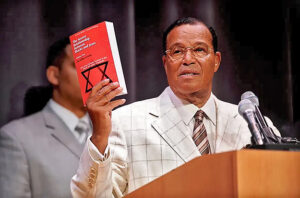
7.26 Noah Berger. Louis Farrakhan speaks at UC Berkeley, March 13, 2012. Dimensions variable. Digital file.
In the US, celebrity athletes, entertainers, entrepreneurs, neo-Nazis, preachers, and politicians push the ugliest antisemitic conspiracies into the mainstream via social media.[xxv] These hateful figures include, but are not limited, to Ye (Kanye West), Kyrie Irving, Nick Fuentes, Louis Farrakhan, former US president Donald Trump, and the MAGA movement.[xxvi] This was exasperated by Trump’s call to terminate the US constitution so he can be reinstated as POTUS, writing: “A Massive Fraud of this type and magnitude allows for the termination of all rules, regulations, and articles, even those found in the Constitution.”[xxvii] He followed this by saying: “Jewish leaders ‘lack loyalty’ and should be ‘ashamed.’”[xxviii] The response from the US Republican party has largely been deafening silence and/or deflection.[xxix] This raises the issue that there is one standard for hate speech targeting non-Jews and another for antisemitic hate speech.[xxx] As President Biden tweeted on December 2, 2022: “And instead of giving it a platform, our political leaders should be calling out and rejecting antisemitism wherever it hides. Silence is complicity.”
To add to the idiocy, German Special Forces and police recently arrested twenty-five people across the country for plotting a coup against the German state, led by an antisemitic descendant of one of the royal families of the former German Empire.[xxxi]
In the US, a number of law student groups at the University of California, Berkeley voted to ban pro-Israeli speakers, making a mockery of the 1st Amendment at the home of the 1960s Free Speech Movement.[xxxii]
Piling on, a newly elected Republican member to the US House of Representatives from New York State, George Santos, campaigned as a “proud American Jew” whose grandparents survived the Holocaust, only to have his claims exposed as a tissue of lies.[xxxiii]
To top it off, US House Republican leaders placed Rep. Marjorie Taylor Greene (Georgia) on the House Oversight and Accountability Committee, the chamber’s main investigative panel. Quite a substantial reward for the QAnon believer who deceptively claimed that Jews have been using lasers in space to start forest fires.[xxxiv]
Finally, another cohort in this coalition of detestation are the antisemites of other minorities. This includes Blacks, Hispanics, and Muslims, who commit the majority of anti-Jewish hate crimes in New York. Yet some equal rights advocates either ignore or refuse to discuss this paradox, thus declaring these individuals are not responsible for their actions, which robs them of their agency and power to be equal.[xxxv]
As poet Maya Angelou, a devoted reader of Holocaust survivor Elie Wiesel’s work and who utilized her poetry for Holocaust commemoration, told Oprah Winfrey, she was a ‘Jewish woman,’ proclaiming: “When people show you who they are, believe them the first time.”[xxxvi]
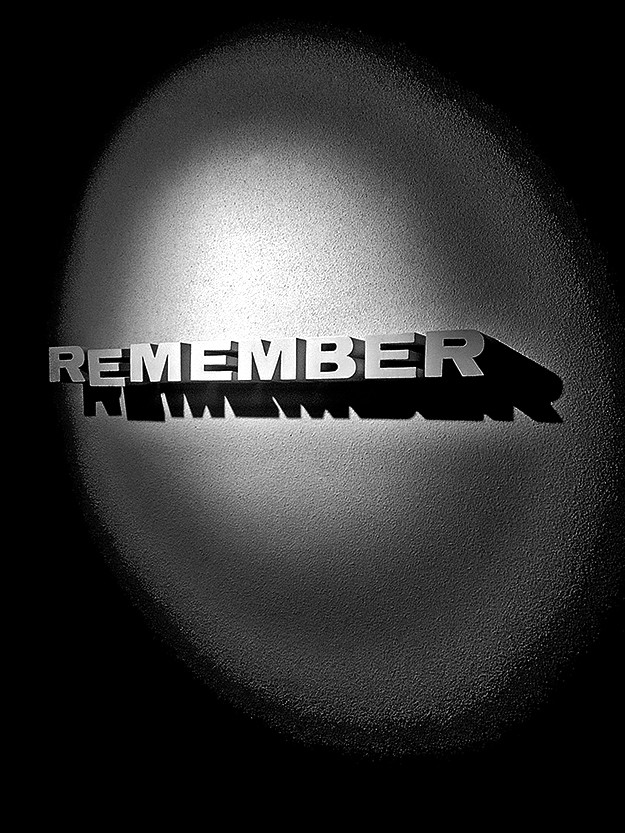
7.27 Robert Hirsch. Remember, 2018. Dimensions variable. Digital file.
Acknowledgements
Research assistance and project management by Ruby Merritt
Noteworthy thanks to Lisa Murray-Roselli for her first-rate editing expertise.
Feedback and suggestions are welcome.
This series of essays is supported by the following organizations and individuals:
VASA: Roberto Muffoletto, Director
CEPA Gallery, Buffalo, NY USA: Claire Legget, Acting Executive Director
Holocaust Resource Center of Buffalo, Buffalo, NY USA: Lauren Bloomberg, Acting Director
Jewish Community Center of Greater Buffalo, Buffalo, NY USA: Katie Wzontek, Cultural Arts Director
Endnotes:
[i] See maps at: https://encyclopedia.ushmm.org/content/en/gallery/camp-system-maps
[ii] Details at: Jason Dawsey, “The Liberation of Majdanek,” The National WW II Museum, New Orleans, July 23, 2020, www.nationalww2museum.org/war/articles/liberation-of-nazi-camp-majdanek-1944
[iii] See: Rachel Maddow, Ultra podcast series, www.msnbc.com/rachel-maddow-presents-ultra. It covers American extremism by telling how members of the US Congress were aiding and abetting a plot to overthrow the US government with Nazi assistance.
[iv] Muselmänner was a German slang term used to refer to those suffering from an acute combination of starvation, exhaustion, and despair that left them mute, passive, and fated to die or be murdered.
[v] See: William Graebner. “The Living Dead of George Romero and Steven Spielberg: America, the Holocaust and the Figure of the Zombie,” Dapim Studies on the Holocaust, 31(1):1-26, January 2017, www.researchgate.net/publication/315372831_The_Living_Dead_of_George_Romero_and_Steven_Spielberg_America_the_Holocaust_and_the_Figure_of_the_Zombie
[vi] Bela Braver in Yehudit Kleiman and Nina Springer–Aharoni (eds.), The Anguish of Liberation: Testimonies from 1945 (Jerusalem: Yad Vashem, 1995), 19.
[vii] Yad Vashem. The World Holocaust Remembrance Center, “Anti-Jewish Violence in Poland After Liberation,” www.yadvashem.org/articles/general/anti-jewish-violence-in-poland-after-liberation.html#footnote1_ay6g4wj
[viii] The Anguish of Liberation as Reflected in Art 1945-1947 (on-line exhibition, available in readyu2print format) www.yadvashem.org/yv/en/exhibitions/art-liberation/index.asp
[ix] See video: Deborah E. Lipstadt, “Explaining Holocaust Denial,” US Holocaust Memorial Museum, Washington, DC. www.ushmm.org/antisemitism/holocaust-denial-and-distortion/explaining-holocaust-denial
[x] Jacob Dirnhuber, “These images from the Holocaust are even more chilling in color,” New York Post, March 15, 2018, https://nypost.com/2018/03/15/these-images-from-the-holocaust-are-even-more-chilling-in-color/
[xi] See: Naomi Zeveloff, “Should We Be Colorizing Photographs From Auschwitz?,” Forward, April 17, 2019. https://forward.com/culture/421761/should-we-be-colorizing-photographs-from-auschwitz/
[xii] William I. Hitchcock, The Bitter Road to Freedom: A New History of the Liberation of Europe (New York: Free Press, 2008), 299.
[xiii] Ibid.
[xiv] Ibid., 264.
[xv] Angelica Villa, “Photographer Lee Miller’s Subversive Career Took Her from Vogue to War-Torn Germany,” Art in America, March 19, 2021, www.artnews.com/feature/lee-miller-photography-vogue-man-ray-1234587240/
[xvi] Sharon Sliwinski, “Visual Testimony: Lee Miller’s Dachau,” Journal of Visual Culture Vol. 9 Issue 3 (2010), 395, http://works.bepress.com/sharon_sliwinski/6/
[xvii] www.leemiller.co.uk/media/A-rail-car-in-the-death-train-Doctor-Jacques-Hindermeyer-a-French-medical-expert-who-was-an-eyewitness-stated-that-L/LEtaScmbnzMRD-eePsyWNw..a
[xviii] Lee Miller, “Believe It,” Vogue (US), June 1945, 106.
[xix] Antony Penrose. The Lives of Lee Miller (New York: Holt, Rinehart and Winston, 1985), 147.
[xx] See: Yair Rosenberg, Chappelle Was Right, The Atlantic, November 15, 2022, www.theatlantic.com/ideas/archive/2022/11/why-its-become-harder-to-joke-about-anti-semitism/672120/
[xxi] “Antony Penrose Remembers Lee Miller,” AnOther, August 3, 2012, www.anothermag.com/art-photography/2104/antony-penrose-remembers-lee-miller
[xxii] Steven Fischer, Antisemitism: A Very Short Introduction (New York: Oxford University Press, 2015).
[xxiii] The “stab-in-the-back” was an antisemitic conspiracy that maintained the Imperial German Army did not lose World War I on the battlefield. Instead, Germany was betrayed on the home front by Jews and revolutionary socialists who fomented labor unrest and strikes. It was spread by Generals Paul von Hindenburg and Erich Ludendorff to avoid having to admit their mistakes. This crusade was continued by the Nazis. More at: David Mikics, “The Jews Who Stabbed Germany in the Back,” Tablet, November 9, 2017, www.tabletmag.com/sections/arts-letters/articles/jews-who-stabbed-germany-in-the-back
[xxiv] See: Michael Eric Dyson, “Blacks and Jews, Again,” The New York Times, Nov. 20, 2022, www.nytimes.com/2022/11/20/opinion/kyrie-irving-kanye-west-antisemitism.html?searchResultPosition=1
[xxv] Joseph Menn, “Attacks on U.S. Jews and gays accelerate as hate speech grows on Twitter,” The Washington Post, January 22, 2023, www.washingtonpost.com/technology/2023/01/18/hate-speech-antisemitism-antigay-twitter/?wpisrc=nl_most&carta-url=https%3A%2F%2Fs2.washingtonpost.com%2Fcar-lntr%2F38eb580%2F63cd68bcef9bf67b236c1220%2F596b0f30ade4e24119acddc4%2F40%2F72%2F63cd68bcef9bf67b236c1220
[xxvi] The MAGA movement has provided numerous devotees with an identity, a fount of personal meaning, and a reason to fight. They have cooked up a fairy-tale narrative whereby they are heroic figures fighting malevolent forces. They achieve psychological gratification in relentless conflict; their lives seem more intense and purposeful within MAGA’s ever-combative framework. Politics has become, for them, an ersatz religion. In this galvanized turmoil, they will not listen to reason nor are they open to compromise, the foundation of American democracy. In reality, many of the MAGA’s are searching for excuses to be offended, feel victimized, denied their rightful place in society, and are therefore willing to furiously act out and demonize those who they find unworthy.
[xxvii] Karoun Demirjian and Toluse Olorunnipa, “White House rebukes Trump’s suggestion to suspend Constitution over 2020 election,” The Washington Post, December 3, 2022, www.washingtonpost.com/politics/2022/12/03/trump-constitution-truth-social/
[xxviii] Ron Kampeas, “Jewish leaders ‘lack loyalty’ and should be ‘ashamed,’” Jewish Telegraphic Agency, December 9, 2022, www.jta.org/2022/12/09/politics/trump-jewish-leaders-lack-loyalty-and-should-be-ashamed?mpweb=1161-51655-87485
[xxix] Seth J. Frantzman, “Has antisemitism in US reached a tipping point?,” The Jerusalem Post, December 3, 2022, www.jpost.com/diaspora/antisemitism/article-723990?_ga=2.175136231.473802112.1670133924-1163418029.1645806768&vgo_ee=pe0QfTCmmHdt%2Fu78LjdvmuVBBEpOL%2FVH1LgWNl%2BjZec%3D
[xxx] See: Micha Danzig, “Irving, Stewart, Chappelle and the double standard for Jew-hatred,” The Jewish Journal, November 23, 2022, https://jewishjournal.com/commentary/opinion/353401/irving-stewart-and-chappelle-and-the-double-standard-for-jew-hatred/
[xxxi] Katrin Bennhold & Erika Solomon, “Germany Arrests 25 Suspected of Planning to Overthrow Government,” The New York Times, December 7, 2022, http://www.nytimes.com/2022/12/07/world/europe/germany-coup-arrests.html?searchResultPosition=2;
Katrin Bennhold & Erika Solomon, “Far-Right Group Suspected in German Plot Gained Strength From QAnon,” The New York Times, December 8, 2022, www.nytimes.com/2022/12/08/world/europe/germany-plot-qanon.html?searchResultPosition=3;
Isaac Chotiner, “The Failed Coup Plotters Yearning for the German Reich,” The New Yorker, December 15, 2022, www.newyorker.com/news/q-and-a/the-failed-coup-plotters-yearning-for-the-german-reich?bxid=5be9e2d224c17c6adf6e147d&cndid=34831695&hasha=47e5dec13b974e588518a71bf31afdc0&hashb=573329092c76f0653725fd88fa9b67a9c0d63f9c&hashc=2224b48914b88a6f2091c8632a432bd13317e086ca181b3d061a915702db8727&esrc=AUTO_OTHER
[xxxii] Ari Blaff, “Department of Education Opens Investigation into Berkeley Law after Jewish Students Report Hostile Environment,” National Review, December 20, 2022, https://www.nationalreview.com/news/department-of-education-opens-investigation-after-berkeley-law-student-groups-vow-not-to-host-pro-israel-speakers/
[xxxiii] Andrew Silverstein, “Congressman-elect George Santos lied about grandparents fleeing anti-Jewish persecution during WWII,” Forward, December 21, 2022, https://forward.com/news/529130/george-santos-jewish-lie-genealogy-records/ and Andrew Silverstein,” George Santos’ fake ‘Jew-ish’ story is not the most troubling lie he told,” Forward, January 5, 2023, https://forward.com/culture/530683/george-santos-holocaust-refugee-biggest-lie-jewish/ and Sara Dorn, “George Santos: Everything The Embattled Congressman Has Lied About,” Forbes, January 22, 2023, www.forbes.com/sites/saradorn/2023/01/22/george-santos-everything-the-embattled-congressman-has-lied-about/?sh=1b3d2d8c4004 and David Smith, “‘We don’t know his real name’: George Santos’s unravelling web of lies,” The Guardian, January 22, 2023, www.theguardian.com/us-news/2023/jan/22/george-santos-lies-republican-party-future
[xxxiv] Leigh Ann Caldwell and Amy B Wang, “Greene, Gosar lost committee seats over comments. Now, they’re back,” The Washington Post, January 18, 2023, www.washingtonpost.com/politics/2023/01/17/house-republicans-greene-gosar/
[xxxv] Elliot Kaufman, “Inconvenient Anti-Semites’ in New York’s War on Hate,” The Wall Street Journal, December 17, 2022, www.wsj.com/articles/inconvenient-anti-semites-new-york-hate-crime-kanye-jewish-black-hasidic-brooklyn-11671200214 and Mike Wagenheim, “Who Commits the Vast Majority of Antisemitic Assaults in NYC?,” Jewish News Syndicate, Jan 1, 2023, www.jns.org/other-minorities-committing-vast-majority-of-antisemitic-assaults-in-nyc/
[xxxvi] Hody Nemes, “6 Jewish Memories of Maya Angelou,” Forward, May 28, 2014, https://forward.com/opinion/199067/6-jewish-memories-of-maya-angelou/
Image Notes
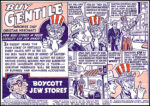 7.3 American Nationalist. Buy Gentile. Patronize only Christian Merchants, Boycott Jew Stores. Photo offset.
7.3 American Nationalist. Buy Gentile. Patronize only Christian Merchants, Boycott Jew Stores. Photo offset.
Caption: How many stores in your locality are Jew owned? In recent years the Main Street of virtually every major city in the U.S. has been taken over by hordes of Eastern-European Jews, who are slowly but surely driving gentile business men into bankruptcy. Unless immediate action is taken – Christian merchants will be driven out of business and commerce altogether. BOYCOTT JEW STORES.
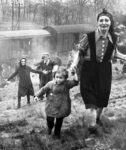
7.7 Major Clarence L. Benjamin. Jewish prisoners after being liberated from a death train, April 13, 1945. Variable dimensions. Gelatin silver print.
7.7 Major Clarence L. Benjamin. Jewish prisoners after being liberated from a death train, April 13, 1945. Variable dimensions. Gelatin silver print.
Caption: This train contained about 2,500 Jews and had left the Bergen-Belsen death camp a few days before with its prisoners packed in like sardines. Their German guards abandoned the train and the captives were discovered by the US the 743rd Tank Battalion. One of US Army tank commanders, Carrol Walsh, later stated: “I cannot believe, today, that the world almost ignored those people and what was happening. How could we have all stood by and have let that happen? They do not owe us anything. We owe them, for what we allowed to happen to them.”
(note: Paul Sorene. “The True Story of The Holocaust Train Rescued From The Heart of Darkness,” Flashbak, June 8, 2019. https://flashbak.com/the-true-story-of-the-holocaust-train-rescued-from-the-heart-of-darkness-friday-april-13th-1945-416548/)
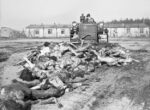
7.8 Sergeant Harry Oakes (1921-1912), A British Army bulldozer pushes bodies into a mass grave at Bergen-Belsen, April 19, 1945. Dimensions vary. Gelatin silver print. Imperial War Museums, UK.
Caption: The bulldozer driver wears a protective handkerchief over his mouth and nose. Oakes was with the British No. 5 Army Film and Photo Section, Army Film and Photographic Unit.
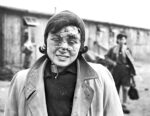
7.10 Captain E. G. Malindine. Beaten woman prisoner, Bergen-Belsen, April 18, 1945. Dimensions vary. Gelatin silver print. Imperial War Museums, UK.
Caption: A young woman photographed two days after the British entered Bergen-Belsen; her face still bears the scars of a terrible beating by the SS guards. Malindine was also with the British No. 5 Army Film and Photo Section, Army Film and Photographic Unit.
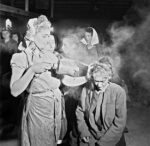
7.11
7.11 Sergeant C. H. Hewitt. De-louseing, May, 4, 1945. Dimensions vary. Gelatin silver print. Imperial War Museums, UK.
Caption: Once bathed and dressed in clean clothes, a former woman inmate is dusted with DDT powder to kill the lice that spread typhus. The dusting was done by other former camp inmates (many of whom were trained nurses before being imprisoned) under the supervision of the Royal Army Medical Corps. Hewitt was also a member of the British No. 5 Army Film and Photo Section, Army Film and Photographic Unit.
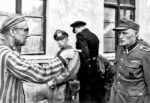
7.12 Unknown photographer. Identifying Nazi guard who brutally beat prisoners, May 14, 1945. Dimensions vary. Gelatin silver print. United States Holocaust Memorial Museum, Washington, DC.
Caption: A Russian slave laborer who was liberated in Buchenwald camp in Germany by U.S. Army 3rd Armored Division points out former Nazi guard who brutally beat prisoners. The guard’s face says it all… Although there were no gas chambers at Buchenwald, hundreds of people were murdered every month from beatings, disease, executions, exhaustion, and malnutrition. Camp records indicate that, throughout its existence, some 240,000 prisoners from at least 30 countries were confined at Buchenwald. At least 10,000 were shipped to extermination camps, and some 43,000 people died at the camp.
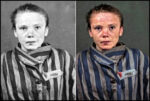 7.13 Unknown photographer and © Marina Amaral. Kwoka, circa 1944. The Auschwitz-Birkenau State Museum, Oświęcim, Poland.
7.13 Unknown photographer and © Marina Amaral. Kwoka, circa 1944. The Auschwitz-Birkenau State Museum, Oświęcim, Poland.
Caption: The worn-down face of 14-year-old prisoner Czesława Kwoka confronts us through time. Upon arrival at Auschwitz, she had her clothes stolen, head shaved, and the number 26947 tattooed on her arm. She was then beaten by guards and dragged off to have her mugshot taken. She was murdered 67 days later when Auschwitz “scientists” injected deadly phenol directly into her heart without using an anesthetic.
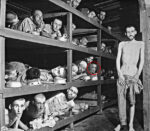
7.15 Unknown photographer. Elie Wiesel among other prisoners, Buchenwald, April 16, 1945. Dimensions vary. Gelatin silver print.
Caption: US troops from the Eightieth Infantry Division liberated Buchenwald in Weimar, Germany, and took photographs of the captives. Even after the prisoners were liberated, many died of malnutrition and disease. Numerous camps were burned down to prevent the spread of epidemics. Future Nobel Peace Prize laureate, Eli Wiesel is pictured (red circle) in the second row of bunks from the bottom, seventh from the left, next to the vertical wooden beam.

7.21 Unknown photographer. Londoners celebrate VE Day, May 8, 1945. Picture Post.
Caption: On May 8, 1945, Britain’s Prime Minister, Winston Churchill, announced that the Second World War was over. This was known as VE Day (Victory in Europe Day). However, the war did not officially end all around the world until September 2, 1945, when Japan surrendered, following the US bombing of Hiroshima and Nagasaki on August 6th and 8th 1945. This was the first use of atomic bombs in warfare—killing and maiming hundreds of thousands of people.
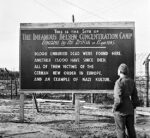
7.22 Sergeant C. H. Hewitt. Sign erected by British Forces at the entrance to Bergen-Belsen concentration camp, Germany, May, 29, 1945. Dimensions vary. Gelatin silver print. Imperial War Museums, UK.
Caption: The remains of the camp itself were about to be burnt to the ground by British occupation forces owing to the fear of disease. A similar sign in German was also erected.
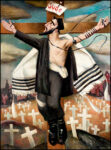
7.23 Emmanuel Levy. Crucifixion, 1942. 40.25 x 30.75 inches. Oil on canvas. Ben Uri Gallery and Museum, London.
Caption: Emmanuel Levy’s Crucifixion is a protest against Jewish persecution in Europe. Levy represented Christ as an orthodox Jew with his Tallit (prayer shawl) and prayer phylacteries (small black leather boxes and straps containing scrolls of parchment inscribed with verses from the Torah). The label ‘Jude’ in blood red above the figure’s head and the rows of white crosses represent the numerous Jews who had already been murdered by the Germans when this work was created.

7.24 Wannsee Conference site, 1942.Courtesy of Bildarchiv preussichen Kulturbesitz, Berlin.
Caption: Pictured left: The villa in Wannsee where the Conference was held. Pictured right: List of the numbers of Jews to be exterminated in each country, totaling about 11,000,000. The list was prepared by Eichmann in preparation for the Wannsee Conference. The countries are listed in two groups, labeled “A” and “B.” Those countries in group “A” were already under Nazi rule at the time of the Conference, while those in group “B” were planned for future conquest and included neutral countries such as Switzerland and Spain, as well as enemies of the Third Reich such as England.

7.26 Noah Berger. Louis Farrakhan speaks at UC Berkeley, March 13, 2012. Dimensions variable. Digital file.
Caption: Louis Farrakhan promoting, The Secret History Between Blacks and Jews (1991), a three-volume work of pseudo-scholarship, published by the Nation of Islam, blaming Jews for the slave trade, plantation slavery, Jim Crow laws, sharecropping, and over-all Black oppression. Henry Louis Gates, Jr. head of the department of Afro-American studies at Harvard University, called the book “the Bible of new antisemitism.” (note: Gilles Kepel Allah in the West: Islamic movements in America and Europe (Stanford University Press, 1997) 68–69.)
